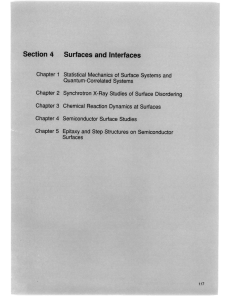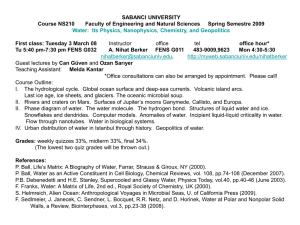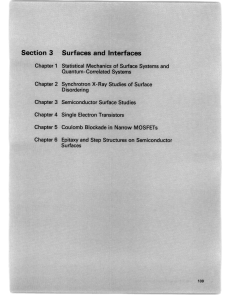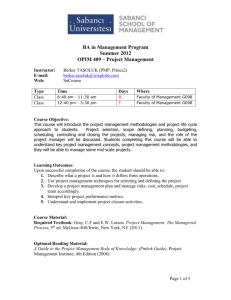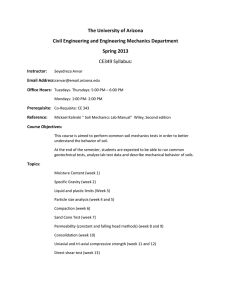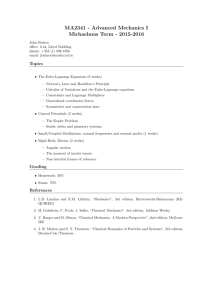4 Interfaces Sction
advertisement
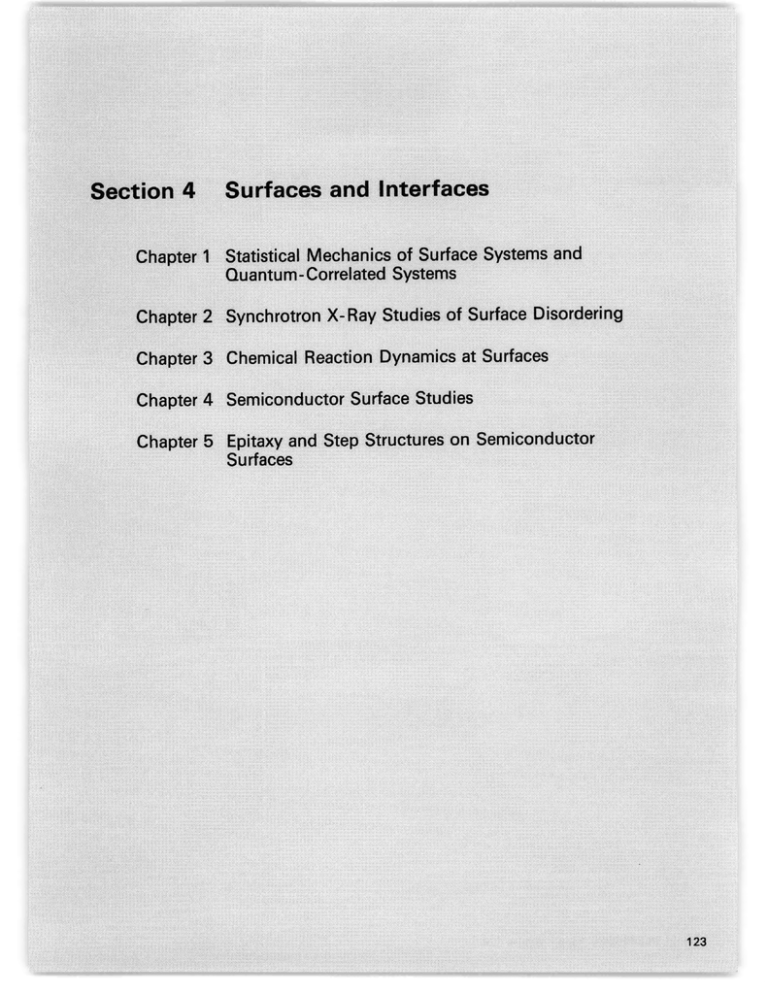
Sction 4 Surfaces and Interfaces Chapter 1 Statistical Mechanics of Surface Systems and Quantum- Correlated Systems Chapter 2 Synchrotron X-Ray Studies of Surface Disordering Chapter 3 Chemical Reaction Dynamics at Surfaces Chapter 4 Semiconductor Surface Studies Chapter 5 Epitaxy and Step Structures on Semiconductor Surfaces 123 124 RLE Progress Report Number 134 Chapter 1. Statistical Mechanics of Surface Systems Chapter 1. Statistical Mechanics of Surface Systems and Quantum-Correlated Systems Academic and Research Staff Professor A. Nihat Berker Graduate Students Daniel P. Aalberts, Alexis Falicov, William C. Hoston, Jr., Roland R. Netz 1.1 Introduction Sponsor Joint Services Electronics Program Contract DAAL03-89-C-0001 Contract DAAL03-92-C-0001 Our objectives are to develop, using renormalization-group theory and other methods of statistical mechanics, microscopic theories of quantum spin and electronic systems. Our approach is particularly suited to systems with fluctuations due to finite temperatures, impurities, surfaces or other geometric constraints. 1.2 Renormalization-Group Approach to Electronic Systems Project Staff Alexis Falicov, Professor A. Nihat Berker High-Tc superconductivity, metallic magnetism, the metal-insulator transition, and heavy fermion behavior are all phenomena produced by the strong correlations of electrons in narrow energy bands. It is therefore important to study theoretical models that incorporate the strong correlation effects of electrons. The tJ model is such a It is defined on a lattice with one system. spherically symmetric orbital per site by the Hamiltonian Htj = P [ -t This Hamiltonian can be interpreted in two ways: (1) In the case of small J, the system can be thought of as the large U limit of the single-band The Hubbard model of electronic systems. antiferromagnetic exchange comes as a result of a virtual process where one electron hops onto a singly occupied nearest-neighbor site and then hops back. The energy gain for such a process is of the order of t 2 /U since a doubly occupied site has energy U. (2) The system can also be thought of as an electronic system with a "super" exclusion principle where no two electrons (like or unlike spins) are allowed on the same site. The second interpretation does not put any restriction on the size of J. There are few rigorous results available on this system: (1) At half filling, the system reduces to a Heisenberg antiferromagnet. (2) At 2t = + J, the model has been solved by the Bethe-ansatz technique. (3) In one dimension and J = 0, the model has been solved also by the Bethe-ansatz technique. Other attempts to study this model have focused on the ground state and first few excited states. We have decided, instead, to focus on the Our thermodynamic properties of this system. method, the renormalization-group approach, involves solving a statistical mechanics problem by a recursive elimination of the degrees of freedom. Since the Hamiltonian involves a regular lattice, this problem is well suited for the position-space The solution is renormalization-group method. obtained in an expanded space with Hamiltonian H= P [ -t ,<ij>, a (c cj, + h.c.) + (ij> C(Cj + h.c.) + X<ij> (Jsis j + Vnin j) + Xlini] P. 4 J X<ij>(sisj - ninj/ )] P, where P is an operator that projects out all doubly occupied sites, c+ and ci, are creation and annihilation operators for an electron in a Wannier state at site i with z-component of spin a, ni is the electron number operator that counts the total number of electrons at site i, and si is the spin operator. Because of the non-commutativity of quantum techniques of renormalizaoperators, new tion-group theory had to be developed. We have obtained the renormalization-group flows for the effective coupling constants for one-, two-, and three-dimensional systems. The flows determine the phase diagrams and all thermodynamic 125 Chapter 1. Statistical Mechanics of Surface Systems properties. In one dimension, we find, as expected, no finite-temperature phase transition. In two dimensions, we find a single finitetemperature critical point, as previous workers conjectured but were unable to derive. In three dimensions, our preliminary results indicate a rich finite-temperature phase diagram with novel phases, phases transition behaviors, and conductivity phenomena. Our results are also confirmed by our exact small-cluster calculations. 1.3 Phase Diagrams of Semiconductor Alloys Project Staff William C. Hoston, Jr., Roland R. Netz, Professor A. Nihat Berker A study of ternary compounds on face-centeredcubic lattices has been started. The aim of the work is to elucidate the phase behavior of ternary and quaternary semiconductor alloys. These alloys have received recent attention for both fundamental and technological reasons. It has been found that these alloys can exist in the zincblende, chalcopyrite, or possibly stannite structures, involving two interpenetrating fcc lattices on which up to four atomic species exist. One atomic species occupies one of the fcc lattices while three other atomic species may (chalcopyrite, stannite) or may not (zincblende) order on the other fcc lattice. At present, not much is known about the chalcopyrite structure seen in the experimentally obtained Ill-V compounds. There is great interest in learning how stable this chalcopyrite phase is against other possible structures. In recent work by K.E. Newman and collaborators, the Blume-Emery-Griffiths model has been adopted for the study of the zincblende to chalcopyrite or stannite transitions. This model is a spin-1 Ising model with Hamiltonian 22 2 H = JX<ij> si sj + K ,<ij> s sj - Alisi, s i = 0, + 1 The three spin values are each associated with a different species of atom, A, B, or C, which exist on one of the fcc lattices. The other fcc lattice is considered occupied by atomic species D. The systems under consideration have the composition [(AB)1-xC2x]D2The model includes interactions between the A, B, and C atoms. The parameters J and K in the Hamiltonian above are fixed as combinations of these interaction energies. They are chosen so as to give the chalcopyrite structure at low temperature (J < 0) and to control the phase transition 126 RLE Progress Report Number 134 between the chalcopyrite and the zincblende. A controls the relative densities of the species (AB) and C. As a preliminary study, we have completed the global phase diagram study of the Blume-EmeryGriffiths model. We found six new phase diagrams, including novel multicritical topology and two new ordered phases. Thus, we determined that the phase diagram of this simple spin system includes nine distinct topologies and three ordered phases. These results were obtained by a global mean-field theory with four independent order parameters. It is important to note, however, that the choice of J < 0 makes the model on the fcc lattice frustrated, which requires analysis beyond mean-field theory. We have developed a new method, which we have called "hard-spin mean-field theory," that incorporates the hard-spin condition of local degrees of freedom and thereby conserves frustration. We have tested this method on frustrated triangular and stacked triangular lattices with the spin-1/2 Ising model, obtaining excellent results. We are now applying the method to the BlumeEmery-Griffiths model. Our future studies of semiconductor alloys will also include renormalization-group theory. 1.4 Quantum Spin Systems Project Staff Daniel P. Aalberts, Professor A. Nihat Berker We are interested in calculating the thermodynamic properties of quantum mechanical systems at low temperatures, where the distinctive quantum phenomena are important. The first model we consider is the s = 1/2 XXZ model, with Hamiltonian H = ,<ij> [J (ss + sYsy ) + Jz ss ]. This model in two dimensions is of interest in high-To superconductors; it is also of general interest to develop our ability to do the statistical mechanics of quantum systems and to extract, thereby, the quantitative properties of their elementary excitations. We map this d-dimensional quantum system quantitatively onto a (d+l1)-dimensional classical system with complicated interactions. For the ferromagnetic quantum system, we have been able to obtain magnon dispersion relations and magnon-magnon interactions. Eventually, we expect to apply our method to antiferromagnetic Chapter 1. Statistical Mechanics of Surface Systems quantum systems, where even the ground state presents a many-body problem. 1.5 Publications Alerhand, O.L., A.N. Berker, J.D. Joannopoulos, D. Vanderbilt, R.J. Hamers, and J.E. Demuth. "Finite-Temperature Phase Diagram of Vicinal Si(100) Surfaces: Alerhand et al. Reply." Phys. Rev. Lett. 66(7): 962 (1991). "Absence of Temperature-Driven Berker, A.N. First-Order Phase Transitions in Systems with Random Bonds." J. Appl. Phys. 70(10): 5941 -5945 (1991). "Absence of Berker, A.N., and K. Hui. Temperature-Driven First-Order Phase Transitions in Systems with Random Bonds." In Science and Technology of Nanostructured Eds. G.C. Hadjipanayis Magnetic Materials. and G.A. Prinz. New York: Plenum, 1991. Berker, A.N., R.G. Caflisch, and M. Kardar. "Statistical Mechanics of Phase Transitions with a Hierarchy of Structures." In Hierarchically I.A. Aksay. Ed. Structured Materials. Pittsburgh: Materials Research Society, 1992. Hoston, W., and A.N. Berker. "Multicritical Phase Diagrams of the Blume-Emery-Griffiths Model with Repulsive Biquadratic Coupling." Phys. Rev. Lett. 67(8): 1027-1030 (1991). "Dimensionality Hoston, W., and A.N. Berker. Effects on the Multicritical Phase Diagrams of the Blume-Emery-Griffiths Model with Repulsive Biquadratic Coupling: Mean-Field and Renormalization-Group Studies." J. Appl. Phys. 70(10): 6101-6103 (1991). Hoston, W. Multicritical Phase Diagrams of the Blume-Emery- Griffiths Model with Repulsive Mean-Field and Coupling: Biquadratic Renormalization- Group Studies. S.M. thesis, Dept. of Physics, MIT, 1991. Netz, R.R. "New Phases and Multiple Reentrance of the Blume-Emery-Griffiths Model with Repulsive Biquadratic Coupling: Monte Carlo Europhys. Theory." Renormalization-Group Lett. 17(4): 373-377 (1992). Netz, R.R., and A.N. Berker. "Monte Carlo MeanField Theory and Frustrated Systems in Two and Three Dimensions." Phys. Rev. Lett. 66(3): 377-380 (1991). Netz, R.R., and A.N. Berker. "Hard-Spin MeanField Theory: Formulation for Ising, XY, and Other Models." J. Appl. Phys. 70(10): 6074-6076 (1991). Netz, R.R., and A.N. Berker. "Monte Carlo MeanField Theory and Frustrated Systems in Two and Three Dimensions: Netz and Berker Reply." Phys. Rev. Lett. 67(13): 1808 (1991). Netz, R.R., and A.N. Berker. "Smectic C Order, In-Plane Domains, and Nematic Reentrance in a Microscopic Model of Liquid Crystals." Phys. Rev. Lett. 68(3): 333-336 (1992). Netz, R.R., and A.N. Berker. "Microscopic Liquid Crystal Theory of Nematic Reentrance, Smectic C Ordering, and In-Plane Domain Formation." In Phase Transitions in Liquid Crystals. Ed. S. Martellucci. New York: Plenum, 1992. Netz, R.R. "Microscopic Theory of the Ripple Phase." In Structure and Conformation of Amphiphilic Membranes. Ed. R. Lipowsky. Berlin: Springer-Verlag, 1992. Netz, R.R. Frustration in Magnetic, Liquid Crystal, and Surface Systems: Monte Carlo Mean-Field Theory. S.M. thesis, Dept. of Physics, MIT, 1991. Meeting Papers American Physical Society Meeting, Cincinnati, Ohio, March 18-22, 1991. Berker, A.N. "Quenched Fluctuation Induced Second-Order Phase Transitions." Hoston, W., and A.N. Berker. "New Multicritical Phase Diagrams from the Blume-EmeryGriffiths Model with Repulsive Biquadratic Interactions." Netz, R.R., and A.N. Berker. "Monte Carlo Mean-Field Theory and Frustrated Systems in Two and Three Dimensions." American Physical Society Meeting, Indianapolis, Indiana, March 16-20, 1992. Aalberts, D.P., and A.N. Berker. "Hard-Spin Mean-Field Theory: Variational Free Energy and First-Order Phase Transitions." Berker, A.N., and R.R. Netz. "Smectic C Order, In-Plane Domains, and Nematic Reentrance in a Frustrated Microscopic Model of Liquid Crystals." 127 Chapter 1. Statistical Mechanics of Surface Systems Netz, R.R. "Symmetry-Breaking Fields in Frustrated Ising Systems on Square and Cubic Lattices." Netz, R.R. "Multiple Reentrance and New Phases from the Blume- Emery-Griffiths Model in Three Dimensions: Monte Carlo Renormalization-Group Theory." International Conference on Thermodynamics and Statistical Mechanics, Berlin, Germany, August 2-8, 1992. Hoston, W., and A.N. Berker. "New Multicritical Phase Diagrams from the Blume-EmeryGriffiths Model with Repulsive Biquadratic Interactions." Netz, R.R., and A.N. Berker. "Monte Carlo Mean-Field Theory and Frustrated Systems in Two and Three Dimensions." NATO Advanced Study Institute on Crystals, Erice, Italy, May 2-12, 1991. Liquid Berker, A.N. "Critical Behavior Induced by Quenched Disorder." Berker, A.N. "Microscopic Theory of Polar Liquid Crystals and Multiply Reentrant Phase Diagrams." Netz, R.R., and A.N. Berker. "Smectic C/A 2 Order, Domains, Reentrance in a Microscopic Model of Liquid Crystals." Netz, R.R., and A.N. Berker. "The Mean-Field Theory for Frustration, Layered Magnets, and Reentrant Liquid Crystals." InternationalLiquid Crystal Conference, 14th, Pisa, Italy, June 21-26, 1992. Statistical Mechanics Meeting, 65th, New Brunswick, New Jersey, May 15-17, 1991. Netz, R.R. and A.N. Berker. "Smectic C Order, Nematic Reentrance, Domains, and Smectic Hoston, W., and A.N. Berker. "Bicritical and Tetracritical Phase Diagrams of the BEG Model: Dimensionality Effects." A,-Smectic A 2 Transitions in a Frustrated Microscopic Model of Liquid Crystals." Magnetism and Magnetic Materials-IntermagConference, Pittsburgh, Pennsylvania, June 18-21, 1991. Berker, A.N. "Absence of Temperature-Driven First-Order Phase Transitions in Systems with Random Bonds." 128 RLE Progress Report Number 134 Netz, R.R., and A.N. Berker. "Microscopic Theory of Smectic A and C Phases of Frustrated Liquid Crystals."
